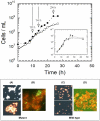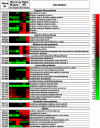A mutant ('lab strain') of the hyperthermophilic archaeon Pyrococcus furiosus, lacking flagella, has unusual growth physiology
- PMID: 25472011
- PMCID: PMC4342268
- DOI: 10.1007/s00792-014-0712-3
A mutant ('lab strain') of the hyperthermophilic archaeon Pyrococcus furiosus, lacking flagella, has unusual growth physiology
Abstract
A mutant ('lab strain') of the hyperthermophilic archaeon Pyrococcus furiosus DSM3638 exhibited an extended exponential phase and atypical cell aggregation behavior. Genomic DNA from the mutant culture was sequenced and compared to wild-type (WT) DSM3638, revealing 145 genes with one or more insertions, deletions, or substitutions (12 silent, 33 amino acid substitutions, and 100 frame shifts). Approximately, half of the mutated genes were transposases or hypothetical proteins. The WT transcriptome revealed numerous changes in amino acid and pyrimidine biosynthesis pathways coincidental with growth phase transitions, unlike the mutant whose transcriptome reflected the observed prolonged exponential phase. Targeted gene deletions, based on frame-shifted ORFs in the mutant genome, in a genetically tractable strain of P. furiosus (COM1) could not generate the extended exponential phase behavior observed for the mutant. For example, a putative radical SAM family protein (PF2064) was the most highly up-regulated ORF (>25-fold) in the WT between exponential and stationary phase, although this ORF was unresponsive in the mutant; deletion of this gene in P. furiosus COM1 resulted in no apparent phenotype. On the other hand, frame-shifting mutations in the mutant genome negatively impacted transcription of a flagellar biosynthesis operon (PF0329-PF0338).Consequently, cells in the mutant culture lacked flagella and, unlike the WT, showed minimal evidence of exopolysaccharide-based cell aggregation in post-exponential phase. Electron microscopy of PF0331-PF0337 deletions in P. furiosus COM1 showed that absence of flagella impacted normal cell aggregation behavior and, furthermore, indicated that flagella play a key role, beyond motility, in the growth physiology of P. furiosus.
Figures





Similar articles
-
Impact of growth mode, phase, and rate on the metabolic state of the extremely thermophilic archaeon Pyrococcus furiosus.Biotechnol Bioeng. 2017 Dec;114(12):2947-2954. doi: 10.1002/bit.26408. Epub 2017 Oct 6. Biotechnol Bioeng. 2017. PMID: 28840937 Free PMC article.
-
Genome sequencing of a genetically tractable Pyrococcus furiosus strain reveals a highly dynamic genome.J Bacteriol. 2012 Aug;194(15):4097-106. doi: 10.1128/JB.00439-12. Epub 2012 May 25. J Bacteriol. 2012. PMID: 22636780 Free PMC article.
-
Flagella of Pyrococcus furiosus: multifunctional organelles, made for swimming, adhesion to various surfaces, and cell-cell contacts.J Bacteriol. 2006 Oct;188(19):6915-23. doi: 10.1128/JB.00527-06. J Bacteriol. 2006. PMID: 16980494 Free PMC article.
-
Studies on the base excision repair (BER) complex in Pyrococcus furiosus.Biochem Soc Trans. 2009 Feb;37(Pt 1):79-82. doi: 10.1042/BST0370079. Biochem Soc Trans. 2009. PMID: 19143606 Review.
-
Sugar utilization and its control in hyperthermophiles.Extremophiles. 1998 Aug;2(3):201-5. doi: 10.1007/s007920050061. Extremophiles. 1998. PMID: 9783166 Review.
Cited by
-
Random mutagenesis of the hyperthermophilic archaeon Pyrococcus furiosus using in vitro mariner transposition and natural transformation.Sci Rep. 2016 Nov 8;6:36711. doi: 10.1038/srep36711. Sci Rep. 2016. PMID: 27824140 Free PMC article.
-
The transcriptional regulator EarA and intergenic terminator sequences modulate archaellation in Pyrococcus furiosus.Front Microbiol. 2023 Nov 9;14:1241399. doi: 10.3389/fmicb.2023.1241399. eCollection 2023. Front Microbiol. 2023. PMID: 38029142 Free PMC article.
-
A LuxR-type regulator, AcrR, regulates flagellar assembly and contributes to virulence, motility, biofilm formation, and growth ability of Acidovorax citrulli.Mol Plant Pathol. 2020 Apr;21(4):489-501. doi: 10.1111/mpp.12910. Epub 2020 Jan 14. Mol Plant Pathol. 2020. PMID: 31943660 Free PMC article.
-
Next Generation DNA-Seq and Differential RNA-Seq Allow Re-annotation of the Pyrococcus furiosus DSM 3638 Genome and Provide Insights Into Archaeal Antisense Transcription.Front Microbiol. 2019 Jul 12;10:1603. doi: 10.3389/fmicb.2019.01603. eCollection 2019. Front Microbiol. 2019. PMID: 31354685 Free PMC article.
-
Rv3737 is required for Mycobacterium tuberculosis growth in vitro and in vivo and correlates with bacterial load and disease severity in human tuberculosis.BMC Infect Dis. 2022 Mar 14;22(1):256. doi: 10.1186/s12879-021-06967-y. BMC Infect Dis. 2022. PMID: 35287590 Free PMC article.
References
-
- Blumentals, Brown SH, Schicho RN, Skaja AK, Costantino HR, Kelly RM. The hyperthermophilic archaebacterium, Pyrococcus furiosus. Development of culturing protocols, perspectives on scaleup, and potential applications. ANN NY Acad Sci. 1990;589:301–314. - PubMed
-
- Chen S, Calvo JM. Leucine-induced dissociation of Escherichia coli Lrp hexadecamers to octamers. J Mol Biol. 2002;318:1031–1042. - PubMed
Publication types
MeSH terms
Grants and funding
LinkOut - more resources
Full Text Sources
Other Literature Sources
Molecular Biology Databases
Miscellaneous

